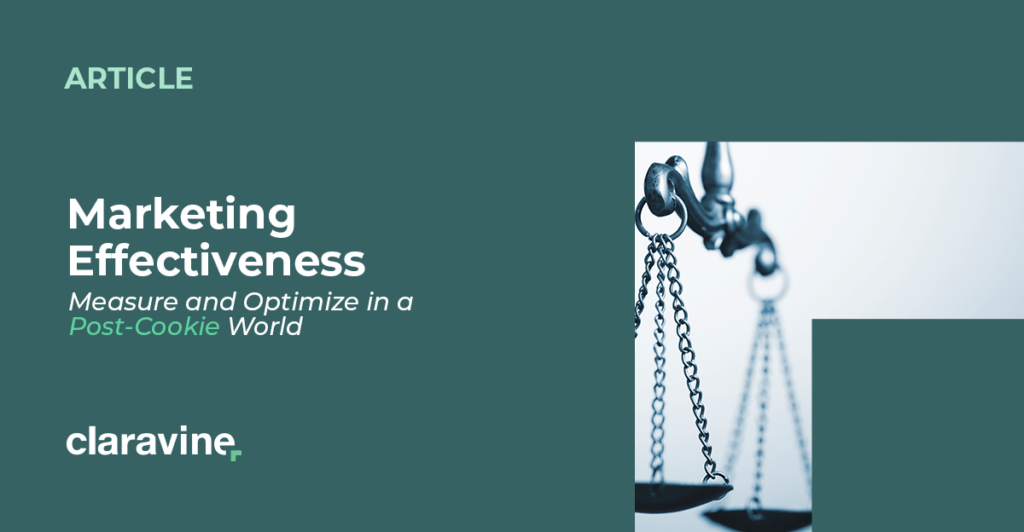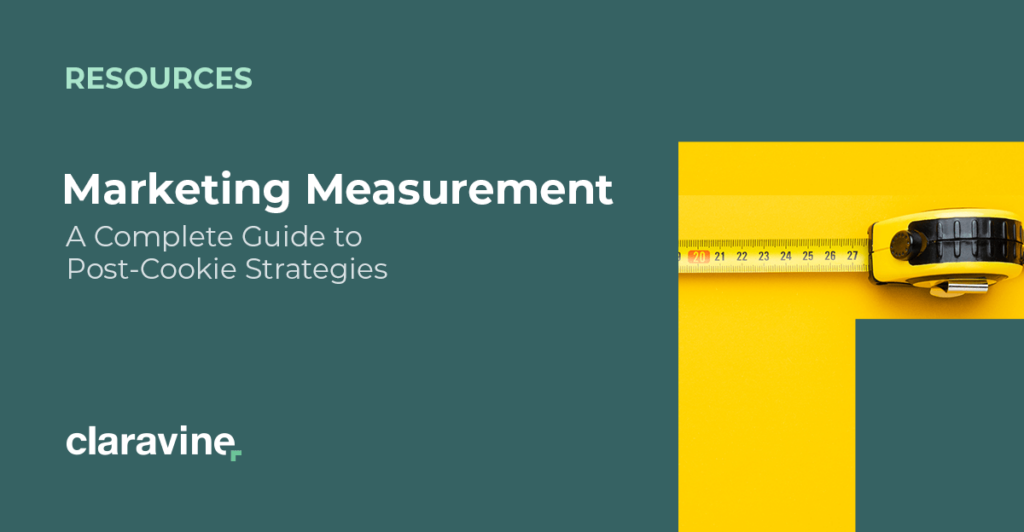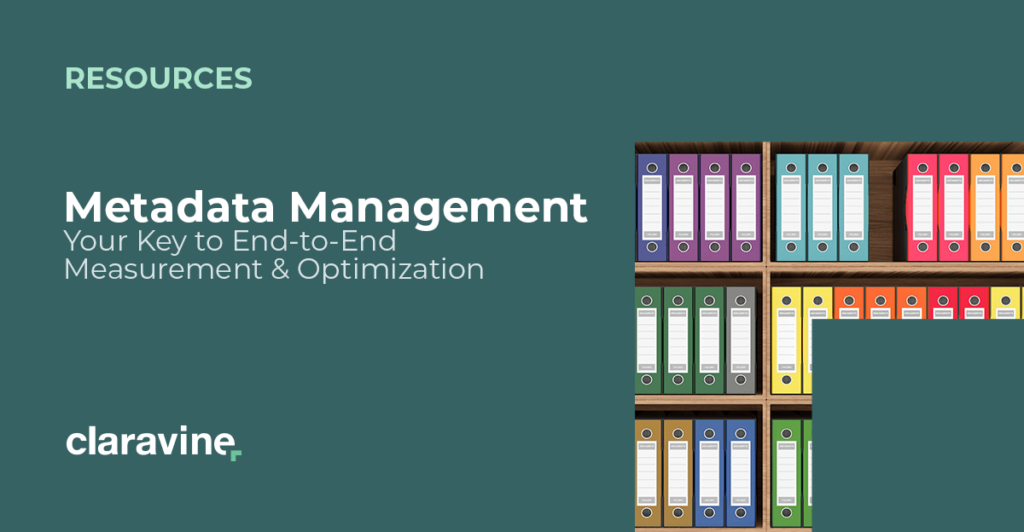The Marketing Effectiveness Director Might Be the Most Crucial Role of Post-Cookie Marketing

You’re here because you’re facing an uncomfortable truth: not only are your marketing campaigns not living up to expectations, you’re not even confident in the measurements you’re making. But you’re in the right place — learning about the emergence of marketing effectiveness as the determination of success and ROI.
Today’s marketer has almost too many marketing channels and tactics to choose from. Too many choices could be why marketers estimate they waste 26% of their marketing budget.
You’re probably in the same boat — and likely spinning your wheels on ineffective media elements or playing it safe with tried-and-true methods. But a little innovation and analysis could drive even more revenue.
If you’re new to the subject of marketing effectiveness in the post-cookie world, we’ll put you on the path to gaining a holistic view of marketing’s contribution to your company’s bottom line.
We’ll start with a definition of marketing effectiveness and how to measure it. Then we’ll detail some essential marketing effectiveness measurement metrics (and clear up any confusion between marketing and media effectiveness) and an emerging role responsible for both. Finally, we’ll address the barriers to measurement and offer solutions to overcome them.
Marketing Effectiveness Mastery
What Does Marketing Effectiveness Mean?
Marketing effectiveness measures how much revenue campaigns are generating while lowering the cost of customer acquisition.
The way organizations measure marketing performance has evolved as marketers have gained access to real-time data. Modern marketing strategies are data-driven and primarily digital, making today’s campaigns easier to track and measure than offline campaigns.
That goes not just for the data collected on performance, but on spend, too. Add to that investments in content and creative, the people running the campaign, and even the tertiary value fo the data collected (e.g., richer customer profiles) and it’s clear that marketing effectiveness is an elevation of our standard understanding of marketing performance.
Admittedly, it’s a subtle distinction. But an important — nay, game-changing — shift in thinking.
Which of course has you wondering:
How to Measure Marketing Effectiveness (Hint: Incrementality)
One of the most effective ways marketing can prove its value to the organization is through incrementality testing and measurement that showcases the incremental benefits of specific marketing activities. Marketing effectiveness can be quantified through these incremental lifts and categorized around various customer touchpoints, channels, campaigns, and other strategic segments.
Incrementality in marketing refers to the lift in the desired outcome for a campaign, such as brand awareness, conversions, lead generation, website visits, and more. And it helps identify what causes a user to convert, so organizations can better allocate budget, reduce wasted spend, and optimize their marketing mix.
Here are a few insights marketers can glean through incrementality measurements of marketing effectiveness:
- Which campaigns are contributing to the desired outcome and which are not
- What happens if budgets are increased or decreased for a specific channel
- Which ads should be served to a given audience and on what platform
Other marketing measurement methods like multi-touch attribution and media mix modeling essentially measure clicks. Incrementality testing accounts for impressions and clicks, which is essential for measuring channels within walled gardens or social platforms for which impressions are challenging to map and measure.
The crucial aspect that sets marketing effectiveness measurement apart from regular-old marketing measurement is the arm-in-arm relationship with investment: an incremental lift isn’t the whole story — it must be contextualized with the investment behind it.
Up slightly, but with significantly higher investment, can still be a negative for marketing effectiveness. Similarly, down only slightly but with significantly lower spend could still be a win for marketing effectiveness. The same goes for the resulting conversion value of a marketing campaign — perhaps a campaign was altered and resulted in far fewer clicks, but brought in much higher-value customers. That’s a win for marketing effectiveness even if a surface-level analysis might reveal disappointing click data.
8 Marketing Effectiveness Metrics to Rally Around
With access to meaningful, real-time data, marketers can shift away from the high-volume, top-of-funnel marketing tactics of the past. Now it’s easier to align marketing campaigns with MarkOps KPIs to fuel real growth for the business, measured not only by resulting outputs, but the (investment) inputs that created them.
But with the massive amounts of data to contend with (data sprawl — watch out!), it can be challenging to pinpoint the metrics that matter — and some marketing metrics matter more than others, especially when it comes to effectiveness.
Here are some essential metrics to measure marketing effectiveness.
- Marketing contribution to revenue: The percentage of company revenue that can be traced back to marketing efforts
- Return on marketing investment (ROMI): Measures the overall gain or loss created by a specific marketing campaign or overall marketing mix
- Conversion rate: The percentage of users that complete the desired action (caveat — this should usually be considered alongside CPL and conversion value for the true story on effectiveness)
- Pipeline growth and velocity: Tracks the new leads introduced into the pipeline and the amount of time it takes to move prospects from one stage in the customer journey to another
- Cost per lead (CPL): The investment required to produce a single new lead, whatever that means for your business (i.e., website visit, content download, product demo or trial, and more)
- Lead-to-customer conversion rate: Measures how many leads become paying customers — similar to pipeline growth, but less considering sales cycle and moreso contract value
- Engaged time: Measures the value of your content marketing effectiveness by revealing how long target users are actively paying attention
- MQL to SQL ratio: The percentage of marketing qualified leads that convert to sales qualified leads, an indicator of marketing’s ability to qualify and screen leads to fuel robust pipelines
The thread here? You’re not just getting eyeballs and clicks, you’re getting the right eyeballs and more valuable clicks. If marketing measurement is like using a tape measure, marketing effectiveness measurement is more akin to using a balance scale.
The Difference Between Marketing Effectiveness and Media Effectiveness (Example)
Marketing effectiveness and media effectiveness are often used interchangeably, but there is an ever-so-subtle distinction. (Granted, if you mix up and use the wrong term in conversation with your CEO, you’ll probably be fine.)
We’ve already addressed marketing effectiveness and that it pertains to the overall impact of your marketing efforts on the bottom line. Media effectiveness relates to the efficacy of, specifically, your media marketing efforts — or how well you leverage various media elements to reach your target audience.
Now, the definition of media is different depending on who you ask. For example, some sources define media elements as paid media (PPC ads, sponsored content). In contrast, others broaden the definition to include any type of channel — traditional or digital, offline or online, including print, radio, tv, search (SEO), email, social media, and more.
But let’s not get hung up on definitions as they tend to evolve. And the way you define media doesn’t change the distinction between marketing effectiveness and media effectiveness.
For example, a reverse mortgage lender wants to evaluate media effectiveness. Their media mix includes:
- traditional mailers
- radio spots
- search engine ads
- Facebook ads
- Twitter ads
Once they measure the effectiveness of each type of media, and even specific media assets within that category, they’d discover the obvious — that Twitter wasn’t attracting their target audience: seniors.
So, in this simplified example, the lender would shift resources from Twitter ads to one of their existing high-performing media types, such as seniors’ preferred social media platform (Facebook), or a promising new channel (have you heard of Bing?).
In evaluating media effectiveness, the lender determined that one element in their media mix is ineffective and will adjust accordingly. If they wanted to assess marketing effectiveness, they would look at their marketing efforts’ overall impact on revenue. And a single marketing campaign can include a mix of media elements across numerous channels.
To further assess media effectiveness, they might repurpose the “winning” media — in this case, say Facebook ads — to update the graphics on their mailers.
So, think of media effectiveness as a subset of marketing effectiveness, being that media is a tool used for marketing. But it rarely makes sense to consider them separately (data in silos is never a good thing, really).
Meet the Director of Marketing & Media Effectiveness
Marketing effectiveness is The New Black in the enterprise marketing organization.
Brands recognize they must innovate and differentiate how they reach their audiences to stay relevant and competitive in a digital-first, post cookie world. As a result, skilled marketers are in greater demand across all industries than ever — LinkedIn reported a 63% growth in marketing jobs during one recent six-month period.
New leadership roles are emerging as organizations adopt a data-driven approach to enterprise decision-making and marketing efforts. One notable new role is the director of marketing and media effectiveness.
This modern iteration of the traditional marketing director title must be a creative, strategic visionary and an analytics whiz who can unearth insights to prove marketing’s impact on the business, consistently.
Depending on the organization’s size, the role may be split into two distinct functions: one that focuses on overall marketing effectiveness and the other on media effectiveness. In either case, the person holding the role typically rises up through the ranks of analytics, rather than marketing. It tends to be a data-driven role that sees number-lovers evolve into storytellers, rather than creatives adopting data-informed practices.
A director of marketing effectiveness must have:
- Analytics expertise: Data storytelling, mobile apps, web analytics, CRM, reporting tools, data mining, competitive research, modeling analytics, branding, budgeting, etc.
- Digital marketing experience: Social media, paid media, search engine optimization, content marketing, email marketing, etc.
- Experience with best-in-class marketing sciences: Marketing mix modeling, multi-touch attribution, unified marketing measurement, incrementality testing, cohort marketing, data clean rooms, etc.
Typical responsibilities include:
- Leading the measurement strategy and optimization efforts for campaigns and creating new reporting and process milestones
- Overseeing media mix modeling and multi-touch attribution capabilities
- Identifying media insights and converting them into successful campaign strategies and optimizations
- Growing the organizations’ marketing sciences coverage
- Partnering with leadership and stakeholders for regular planning, forecasting, measuring, marketing ROI calculating, and strategizing collaborations
Overcoming Barriers to Marketing Effectiveness Measurement
Your ability to accurately measure marketing and media effectiveness ultimately hinges on one thing — how your organization handles its data.
If you’ve already reduced your reliance on third party cookies and shifted to first party data collection, you’re off to a good start. But unless you establish enterprise marketing data standards, you’re essentially flying blind with your marketing campaigns and setting yourself up for measurement blackout. Data standards refer to a common data language, or a shared format and definition for data as its created and collected.
But what does “handling your data” mean in this context?
First: metadata management. Without strong metadata management and a consistent classification system (marketing taxonomy), it’s nearly impossible to pinpoint the data you need to create relevant, targeted campaigns, let alone measure their effectiveness later. A lack of metadata management will also make cross-functional measurement excruciatingly difficult, since data will be stuck in disparate silos and formats that don’t mesh.
On a grander scale, data integrity. Data standards and data integrity go hand in hand. So when data standards aren’t in place, marketers can’t trust the integrity of the data they manage to pull from data stores or generate from campaigns. Adopting strong data standards is the most important step you can take to support your organization’s marketing efforts to create relevant, impactful campaigns — or, marketing that’s more and more effective.
Are you ready to take on the roles and responsibilities of Marketing Effectiveness at your organization? If so…






